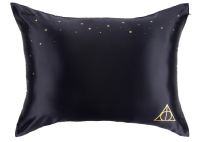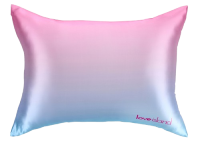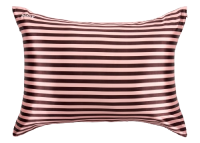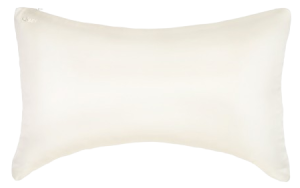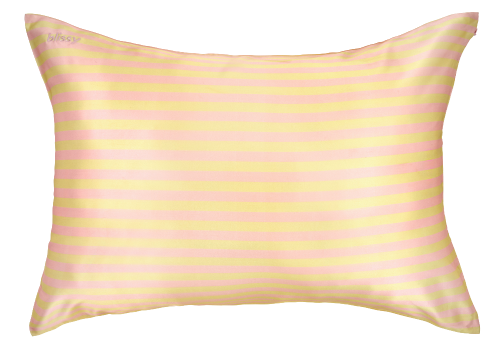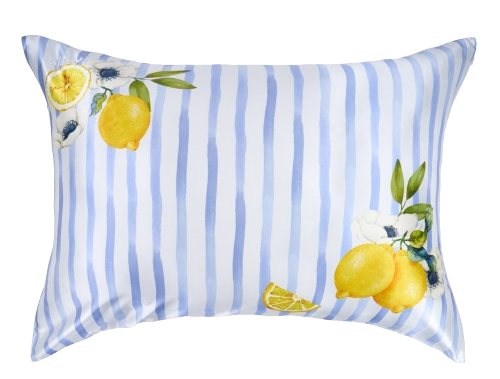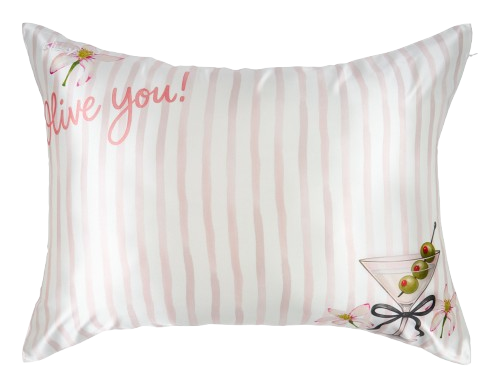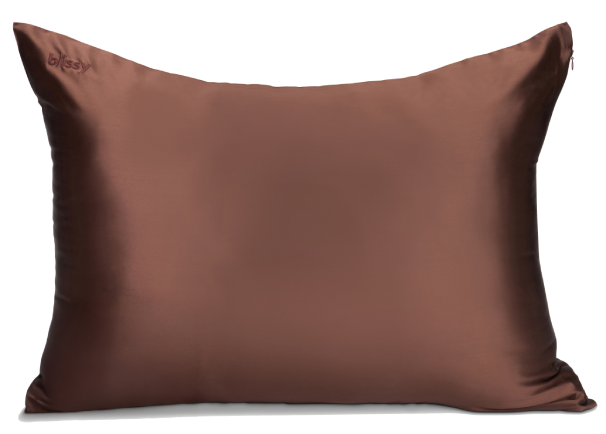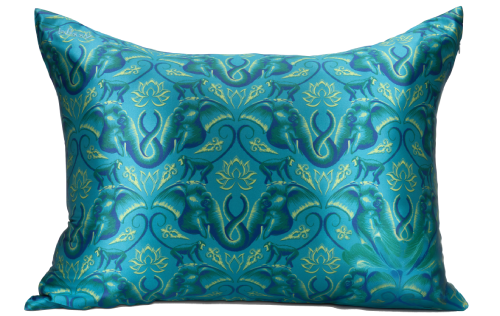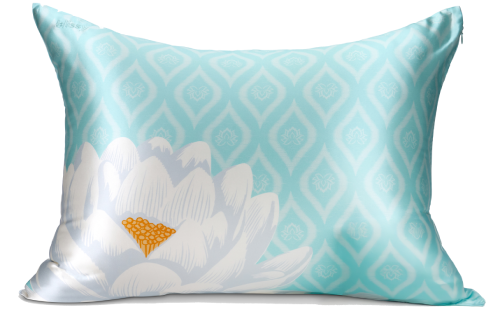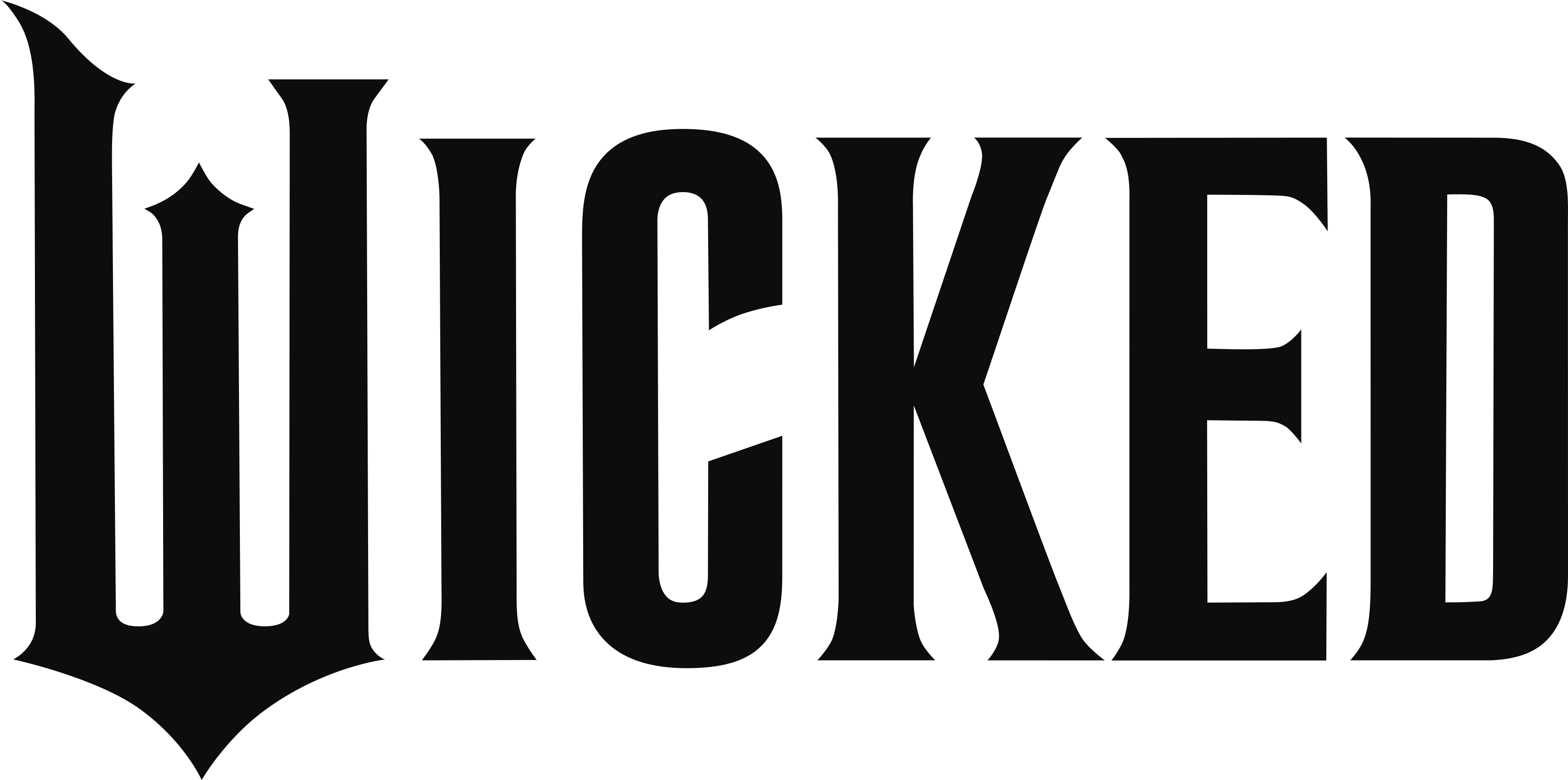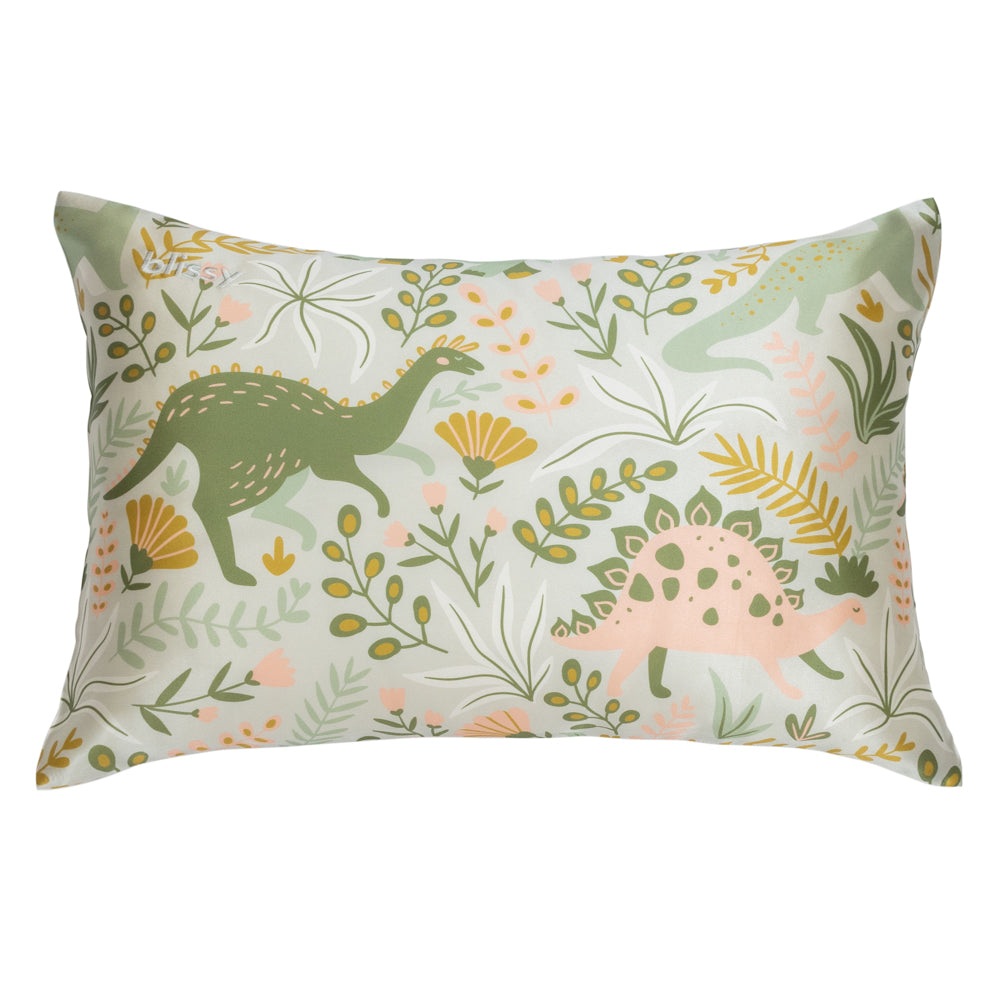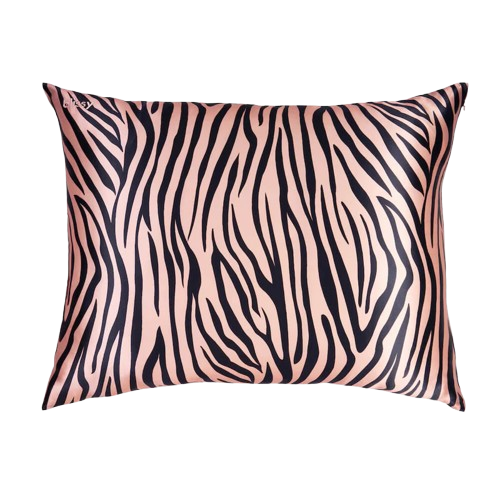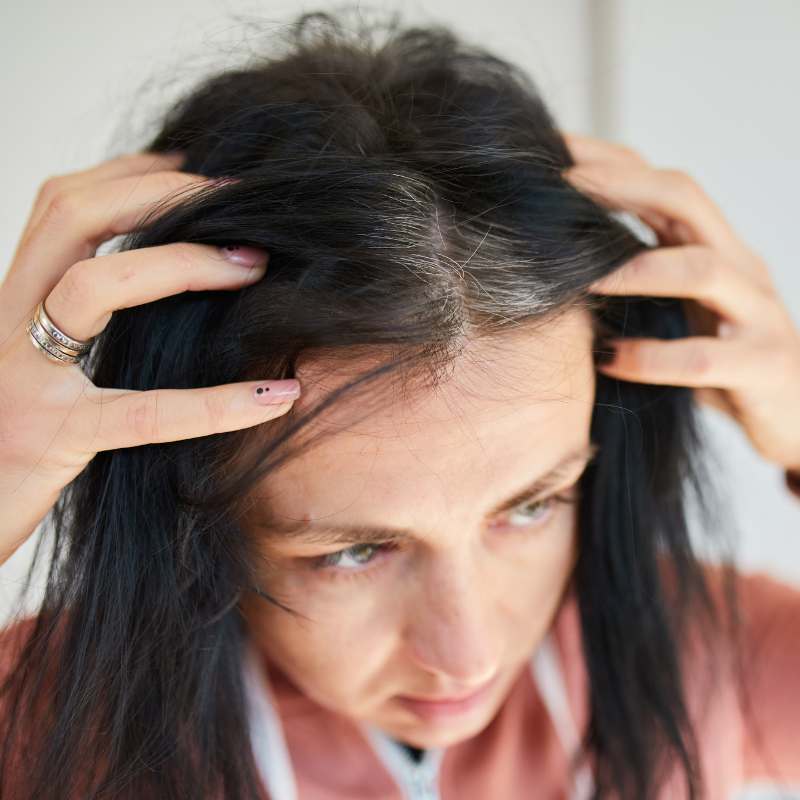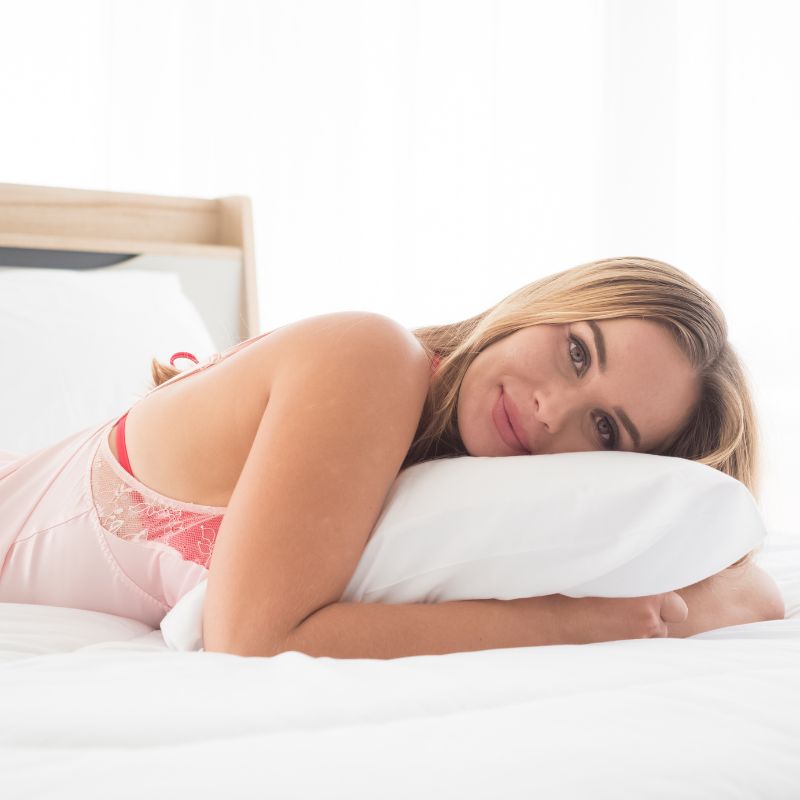Key Takeaways:
-
Chronic stress disrupts the hair growth cycle, triggering excessive shedding and thinning.
-
Elevated cortisol levels weaken follicles and block new hair growth.
-
Most stress-related hair loss is temporary and reversible with proper care.
-
Silk pillowcases and stress management help protect and restore healthier hair.
If you’ve been finding more hair in your brush lately—or worse, watching it swirl down the shower drain—you might be wondering if stress is to blame.
And honestly? It probably is.
Significant stress is often a trigger for hair loss, and ongoing or intense stress can disrupt your hair cycle, leading to increased shedding.
Stress and hair loss are more connected than most people realize. That overwhelming work project, the family drama that won’t quit, or even recovering from being sick can all send your hair into panic mode.
And unlike stress breakouts that show up immediately, hair loss is sneaky—most people start noticing increased shedding months after the stressful event, making it tough to connect the dots.
But here’s the thing: understanding what’s happening to your hair is the first step to fixing it.
So let’s break down exactly how stress messes with your strands, the warning signs you shouldn’t ignore, and—most importantly—what you can actually do about it (including one surprisingly simple bedtime switch that could save your hair).
How Stress Throws Your Hair Growth Out of Whack
Okay, quick hair biology lesson (we promise to keep it simple): Your hair grows in three stages—the growing phase (anagen phase), transitioning, and the resting phase (telogen phase).

How Stress Disrupts Your Hair Growth Cycle
Normally, most of your hair is in the anagen phase, happily doing its thing.
But when stress enters the chat? All bets are off. Stress can shorten the anagen phase and cause more hairs to enter the telogen phase, leading to increased shedding.
Can Stress Cause Hair Loss by Halting Growth?
Stress hormones—especially cortisol—basically tell your hair follicles to stop growing and go into hibernation mode. It’s like your body’s saying, “We’ve got bigger problems right now than making hair.”
So instead of 85-90% of your hair actively growing, a much bigger chunk decides to take a break. And once those follicles rest for a few months, all that hair sheds at once.
Fun, right?
Chronic Stress and Hair Follicle Stem Cell Suppression
Even worse, these stress hormones don’t just pause growth—they actually prevent new hair from starting.
According to research from the Harvard Stem Cell Institute, stress can block the activation of the tiny stem cells that live at the base of each follicle.
These little guys are responsible for creating new hair, so when they’re not working, your hair can’t regenerate properly.
Hair growth involves the activation of stem cells within the hair follicle, and stress hormones can disrupt this process by prolonging the telogen phase and impairing stem cell activity.
Stress-Related Hair Loss Often Shows Up Late
The frustrating part?
This whole process takes 2-3 months to show up. So by the time you notice your hair thinning, the damage was done weeks ago. That’s why people often can’t figure out what caused their hair loss—the stressful event is long gone by the time the shedding starts.
Hair Loss from Stress Is Backed by Science
Research from Harvard’s Stem Cell Institute suggests that chronic stress can suppress hair follicle stem cells—limiting your hair’s ability to regrow effectively and potentially contributing to chronic telogen effluvium [6].
Why Your Hair Follicles Are So Sensitive to Stress
Think of your hair follicles as tiny factories. When everything’s running smoothly, they’re pumping out hair like nobody’s business.
But hair follicles need a steady supply of nutrients, oxygen, and the right hormonal signals to keep working.
Chronic Stress Affects Blood Flow and Nutrients
When chronic stress floods your system with cortisol, it’s part of the body's natural stress response, which can negatively impact hair follicle health by reducing blood flow to your scalp and disrupting the chemical signals these follicles need.
Research from Harvard’s Stem Cell Institute suggests that chronic stress can suppress hair follicle stem cells.
The 5 Warning Signs Your Stress Is Affecting Your Hair
Not sure if stress is behind your hair drama? Here are the telltale signs to watch for.

1. Way More Hair Shedding Than Usual
We all lose hair every day—about 50-100 strands is totally normal [1]. But if you’re suddenly finding clumps in the shower, on your pillow, or clogging your brush? That’s your hair waving a red flag.
Excessive hair shedding is a common sign of stress-related hair loss, often caused by disruptions in the hair growth cycle such as telogen effluvium. Excessive hair loss can be alarming and is often one of the first signs people notice.
This type of shedding—called telogen effluvium—happens when stress pushes too many follicles into the resting phase all at once. When more hairs shed than usual, it is a clear indicator that stress is impacting your hair cycle. Then, about 2-3 months after whatever stressed you out (a illness, major life change, extreme emotional event), all that hair decides to bail at the same time. It’s like your scalp got the memo late.
2. Your Whole Head Looks Thinner (Not Just One Spot)
Unlike genetic hair loss that targets your hairline or crown, stress-related thinning tends to affect your entire scalp. You might notice your ponytail feels thinner, or you can see more scalp when the light hits just right [3].
This all-over thinning is a classic sign of telogen effluvium and what sets it apart from other types of hair loss like alopecia areata, which shows up as circular bald patches. Patchy hair loss is a distinctive pattern often associated with alopecia areata and can be triggered by stress.
3. Your Hair Texture Changed or It's Breaking Like Crazy
Stress doesn’t just make hair fall out—it can also make the hair you still have feel different. Maybe it’s suddenly dry, brittle, or breaking when you style it. That’s because chronic stress may alter circulation and signaling around hair follicles. Reduced hair growth is another consequence of chronic stress, as follicles may not produce new hair as efficiently.
And here’s something most people don’t think about: if your hair’s already weakened by stress, sleeping on a rough cotton pillowcase makes things worse. All that friction and tugging throughout the night? It’s adding insult to injury. (More on that in a minute.)
4. New Hair Growth Is Playing Hide and Seek
Even after the shedding phase ends, you might notice that your hair isn’t filling back in like it should. The regrowth seems slow, patchy, or the new hairs are super fine and wispy [4].
This delayed regrowth is a sign that stress is still keeping your hair follicle stem cells from fully reactivating. Your follicles are stuck in neutral, and they need some serious TLC to get back to work. This is often due to an extended resting phase caused by ongoing stress, which prevents hair follicles from transitioning back to the growth phase.
5. You Can See More Scalp Than Before
When hair loss continues for several months, the cumulative effect starts to show—especially along your part or at the crown. While this can feel pretty scary, it's usually temporary if you address the underlying stress [5].
If you're noticing this along with other symptoms on this list, it's worth checking in with a dermatologist to rule out other causes and figure out a game plan.
What Exactly Is Telogen Effluvium? (And Why It's So Common)
Telogen effluvium is basically when a bunch of your hair follicles go on strike all at once. During this condition, more hairs than usual enter the telogen (resting) phase, which leads to noticeable shedding. It’s the most common type of stress-related hair loss, and it can happen to anyone at any age.

What Sets It Off?
The usual suspects include:
-
Ongoing stress or a major emotional event
-
Hormonal changes (like after having a baby or thyroid issues)
-
Getting seriously ill, running a high fever, or having surgery
-
Not getting enough nutrients (especially iron, vitamin D, or protein)
-
Starting certain medications or losing weight too quickly
The tricky part is that the hair doesn’t fall out during the stressful event—it waits. Your follicles stay in growth mode temporarily, then shift into resting mode together like they planned it. Then, 2-3 months later, boom—massive shedding.
When It's Short-Term vs. Long-Term
Acute telogen effluvium lasts less than 6 months and usually sorts itself out once you remove the stress trigger. Chronic telogen effluvium sticks around for 6 months or longer and might need more help—think stress management, better nutrition, and being extra gentle with your hair.
Some research suggests that ongoing stress is a leading factor in prolonging the resting phase of hair follicles, delaying regrowth. That’s why getting to the root cause—whatever’s stressing you out—is so important.
How Stress Hormones Actually Damage Your Hair

When you’re chronically stressed, your adrenal glands release stress hormones like cortisol (in humans). These hormones can disrupt normal hair growth by suppressing signals from the dermal papilla that activate hair follicle stem cells. The effect is localized to the follicle’s microenvironment rather than causing widespread tissue damage.
Cortisol Is Not Your Hair's Friend
Cortisol blocks the activation of hair follicle stem cells in animal studies, which are the ones responsible for making new hair during the growth phase. No activation = no new hair growth.
The dermal papilla plays a key role in activating stem cells by secreting molecules that promote hair growth, but stress hormones like cortisol can disrupt this process. Targeting these pathways could help promote hair growth by reactivating dormant stem cells. Your follicles just sit there in the resting phase, doing nothing.
Research suggests that elevated cortisol may reduce scalp blood flow and nutrient delivery. That means less oxygen and fewer nutrients reaching your follicles—basically starving them when they need support most. Over time, this creates a vicious cycle: stress weakens follicles, weak follicles make thinner hair, and seeing thin hair stresses you out even more.
Your Immune System Gets Involved Too
Chronic stress can also trigger inflammation around hair follicles and even activate your immune system in ways that attack your own hair. The skin, as the largest organ, plays a crucial role in immune responses that can impact hair growth.
In some cases, this can lead to conditions like alopecia areata, where your body mistakenly targets its own follicles like they’re the enemy.
Other Ways Stress Can Mess With Your Hair
While telogen effluvium is the most common culprit, stress can show up in other hair loss conditions too.

Alopecia Areata
This is an autoimmune condition where your immune system attacks hair follicles, creating smooth, round bald patches. While the exact cause isn't fully understood, stress is a known trigger that can kick it off or make it worse.
Unlike telogen effluvium, alopecia areata can affect any part of your body—scalp, eyebrows, even body hair.
Pattern Baldness (Androgenic Alopecia)
Female pattern hair loss and male pattern hair loss are mostly genetic, but stress can definitely speed things up. If you're already predisposed to thinning, chronic stress basically hits the gas pedal.
Hair Pulling (Trichotillomania)
Some people respond to stress by developing trichotillomania—a compulsive urge to pull out their own hair, often described as an irresistible urge that can be triggered by extreme stress. This one needs specialized treatment, including therapy and stress management techniques.
The Simplest Thing You Can Do Tonight: Switch Your Pillowcase

Here’s something most people don’t realize: the fabric you sleep on every night can make or break your hair recovery.
When you’re already dealing with stress-related hair loss, the last thing you need is more damage. But that’s exactly what happens when you sleep on cotton or synthetic pillowcases. All that friction throughout the night? It’s tugging on fragile follicles, creating tangles, and causing breakage—especially when your hair’s already weakened by stress.
Using the right pillowcase is a simple way to keep your hair healthy during recovery.
Why Silk Is a Total Game-Changer
Silk is naturally smooth and creates way less friction, so your hair can glide across the surface instead of getting caught and pulled. A 2025 lab study by Kosmoscience found that Blissy silk pillowcases:
-
Less frizz and fewer tangles
-
Significantly less breakage during sleep
-
Better protection for delicate and curly hair
What makes Blissy special? Every pillowcase is made from 100% mulberry silk at the highest grade (6A, 22-momme, if you want to get technical), and they're OEKO-TEX certified—meaning no harmful chemicals. With over 230,000 5-star reviews and recommendations from dermatologists, Blissy has basically become the gold standard for people who are serious about protecting their hair.
One customer put it perfectly: "Since I've been using my Blissy pillowcase and bonnet, my hair has been so much better—I've had way less breakage. I'm not losing as much hair as I used to."
Want even more protection? Pair your pillowcase with a Blissy Silk Bonnet—especially if you have textured or longer hair. It keeps your hair fully covered and protected all night long, locking in moisture and preventing any friction.
When you're already dealing with stress-induced shedding, why add more damage on top? Silk won't cure stress-related hair loss, but it's an easy way to protect the hair you have while your follicles recover.
What You Can Do to Help Your Hair Bounce Back
If stress has been wreaking havoc on your hair, here are some tried-and-true ways to support regrowth. Certain treatments and lifestyle changes can also help regenerate hair follicles affected by stress.

1. Get Your Stress Under Control
Managing stress is hands-down the most effective treatment. That might include:
-
Regular exercise (seriously, it lowers cortisol)
-
Meditation, yoga, or just taking deep breaths
-
Actually getting 7-9 hours of sleep
-
Talking to a therapist or leaning on friends and family
Even mild stress, if persistent, can impact hair growth by increasing stress hormones and prolonging the hair follicle resting phase, so it's important to address all levels of stress.
According to the American Cancer Society, even small improvements in stress levels can lead to noticeable hair regrowth within 3-6 months.
2. Feed Your Hair From the Inside Out
Your hair needs the right nutrients to grow back strong. Make sure you're getting enough:
-
Iron (helps deliver oxygen to follicles)
-
Vitamin D (keeps your hair growth cycle on track)
-
Biotin and B vitamins (support the protein your hair's made of)
-
Protein (it's literally the building block of hair)
If you think you might be deficient, chat with your doctor before loading up on supplements.
3. Try Topical Treatments (If Needed)
For some people, using minoxidil (Rogaine) can help jump-start regrowth by extending the growth phase and increasing blood flow to the scalp. While it's FDA-approved for pattern baldness, some dermatologists recommend it for telogen effluvium too.
4. Be Extra Gentle With Your Hair
While your hair's recovering:
-
Skip tight hairstyles that pull on your roots
-
Go easy on heat styling and chemical treatments
-
Use a wide-tooth comb to detangle gently
-
Definitely switch to a silk pillowcase (seriously, do it tonight)
5. Consider Advanced Options for Stubborn Cases
If your hair loss isn’t improving after several months, treatments like platelet-rich plasma (PRP) therapy or low-level laser therapy might help wake up those dormant follicles. These treatments aim to stimulate hair follicle regeneration and promote new growth. Talk to a board-certified dermatologist to see if these are right for you.
Building Hair That Can Handle Whatever Life Throws at You
While you can't always prevent stress, you can definitely make your hair more resilient:
Keep Up a Solid Hair Care Routine
Consistent, gentle care matters—even when you're going through it. Try:
-
Regular scalp massages (they boost blood flow)
-
Sulfate-free shampoos that don't strip your hair
-
Deep conditioning treatments to strengthen strands
-
Protecting your hair from sun and pollution
Prioritize Sleep (Your Hair Will Thank You)
Bad sleep makes stress worse and throws your hormones out of whack, which only makes hair loss worse. Creating a calming bedtime routine—complete with that silk pillowcase—helps your body actually rest and recover.
Don't Ignore Your Mental Health
Hair loss can be genuinely upsetting, and that stress can make the problem worse. If you're feeling overwhelmed by it all, talking to a therapist can help. Taking care of your emotional wellbeing is just as important as treating your hair.
The Bottom Line: Your Hair Can Recover
Look, stress and hair loss absolutely go hand in hand—but here's the good news: most stress-related hair loss is temporary and reversible. By understanding what's happening to your hair and taking steps to protect it, you can minimize damage and support healthy regrowth.
Whether you're juggling a stressful job, recovering from an illness, or just trying to get through a tough time, small changes really do add up. Getting enough sleep, nourishing your body, and yes—even switching to a silk pillowcase—can make a real difference in how your hair looks and feels.
Ready to give your hair some much-needed TLC? Check out Blissy's Silk Pillowcases and Silk Bonnets—they're clinically proven to reduce frizz, minimize breakage, and support healthier hair while you sleep. With over 2 million happy customers and a 60-night guarantee, you've got nothing to lose (except maybe more hair to your cotton pillowcase).
Your hair's been through enough. It deserves a little silk softness—and so do you.



